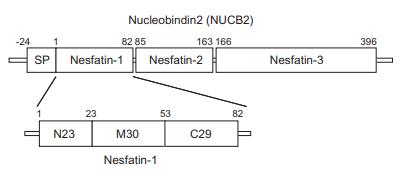| Company Name: |
United States Biological
|
| Tel: |
1-800-520-3011 |
| Email: |
sales@advtechind.com |
| Products Intro: |
Product Name:Nesfatin-1
|
|
| Product Name: | Nesfatin 1 | | Synonyms: | Nesfatin 1;Nesfatin-1 from rat | | CAS: | | | MF: | | | MW: | 0 | | EINECS: | | | Product Categories: | | | Mol File: | Mol File | ![Nesfatin 1 Structure]() |
| | Nesfatin 1 Chemical Properties |
| | Nesfatin 1 Usage And Synthesis |
| Structure | Nesf-1 is posttranslationally cleaved from the 420 aa
protein NUCB2 by the prohormone-convertase into
N-terminal nesf-1[1–82], nesf-2[85–163], and the
C-terminal nesf-3[166–396]. The structure of nesfatin-1
consists of three parts: the first part begins from the
N-terminal end and continues to the 23rd aa (N23); the
second part includes the mid-segment of 30 aa
(M30) between 23 and 53; and the third part includes
the C-terminal segment of 29 aa (C29) between 53 and
82. M30 is effective in food intake and appetite control. Human nesf-1[1–82]: Mr 9551.9; pI 5.28, soluble in
water. | | Gene, mRNA, and precursor | The gene encoding nesf-1, NUCB2, maps to human
chromosome 11p15.1. The human NUCB2 gene is 55 kb
in length, and has 14 exons and 13 introns. Human
NUCB2 mRNA is 2300 bp long, and the product is a
420 aa protein consisting of a 24 aa signal peptide and
a 396 aa protein termed NUCB2. Although nesf-1 cleaved
from NUCB2 has a variety of biological functions, it is still
unknown whether the putative cleavage products nesf-2
and nesf-3 exist and are secreted in vivo. Within the CNS, Nucb2 mRNA is expressed in the
hypothalamus and brainstem. In peripheral tissues,
Nucb2 mRNA is mainly expressed in the gastric mucosa,
pancreas, white adipose tissue, heart, pituitary, and
reproductive organs. NUCB2/nesf-1 immunoreactivity
is detected in the intracellular vesicles of gastric mucosa,
the endocrine cells of pancreatic islets, and the anterior
pituitary. Nesf-1 is able to cross the blood-brain barrier
by nonsaturable transmembrane diffusion, suggesting
that peripheral nesf-1 may access the CNS to exert biological actions. | | Synthesis and release | Fasting leads to a decrease in hypothalamic Nucb2
mRNA levels.1 Refeeding activates NUCB2/nesf-1 positive neurons in the supraoptic nucleus. In vitro, glucose
elevates Nucb2 mRNA expression and NUCB2/nesf-1
secretion from cultured stomach ghrelinoma cells10 and
isolated pancreatic islets. On the cellular level in the
hypothalamic paraventricular nucleus (PVN), nesf-1 is
located mainly in secretory vesicles in perikarya near
the Golgi apparatus but not in axon terminals, suggesting
a dendritic release and eventually autocrine or paracrine
actions. | | Receptors | The putative NUCB2/nesf-1 receptor has not yet been
identified. Autoradiography using 125I-nesf-1 as a surrogate for the putative expression of the receptor showed
nesf-1 binding in the brain, including the cortex, PVN,
area postrema, dorsal motor nucleus of the vagus nerve,
and cerebellum as well as in peripheral endocrine organs
including the pituitary, stomach, small intestine, pancreas, adrenal gland, testis, and visceral adipose tissue. In cultured rat hypothalamic neurons, nesf-1 induced
an elevation of intracellular Ca2+ concentration, and the
responseis abolished by pertussis toxin treatment,indicating the participation of a Gi/o protein-coupled receptor. Nesf-1 increases the phosphorylation of CREB without
inducing cAMP formation in a neuroblastoma cell line. Additionally, nesf-1 stimulates MAPK signaling. | | Biological functions | NUCB2/nesf-1 expression sites have been found in
both central and peripheral tissues. NUCB2/nesf-1
affects the glucose metabolism by increasing insulin sensitivity. The peripheral infusion of nesf-1 reduces adiposity and plasma levels of triglyceride and
cholesterol. The administration of nesf-1 increases the
heart rate and blood pressure in rats and fear- and
anxiety-related behaviors. The inhibition of hypothalamic NUCB2/nesf-1 signaling by using an adenoviralmediated RNA interference markedly increased food
intake and hepatic glucose flux, and decreased glucose
uptake in peripheral tissues.19 The inhibition of endogenous NUCB2/nesfatin-1 signaling using ICV anti-nesf-1
antiserum or anti-NUCB2 antisense oligo reduced REM
sleep in the rat. | | Clinical implications | Clinical research in male humans found that the
plasma NUCB2/nesf-1 levels of patients with general
anxiety disorder (GAD) were lower than healthy male
controls. In patients with panic disorder (PD), plasma
NUCB2/nesf-1 levels were obviously elevated compared
to the levels in control subjects. A positive correlation
between NUCB2/nesf-1 levels and PD was observed in
the patient group. Dysfunction of NUCB2/nesf-1 might
be involved in the pathology of some psychiatric disorders.

| | General Description | Nesfatin-1(nesf-1), the 82 aa peptide processed from
nucleobindin 2 (NUCB2), is involved in the regulation of
feeding behavior, gastrointestinal motility, glucose homeostasis, anxiety and depression, cardiovascular functions, thermoregulation, and reproductive functions. Nesf-1 was discovered in 2006 as a potent anorexigenic
peptide in the rat hypothalamus. The 82 aa peptide is
cleaved from its precursor protein NUCB2. In addition
to birds and amphibians, NUCB2 was identified in Cyprinidae, including goldfish and zebrafish. NUCB2 is
widely distributed in the central nervous system (CNS)
and peripheral tissues of vertebrates. |
| | Nesfatin 1 Preparation Products And Raw materials |
|